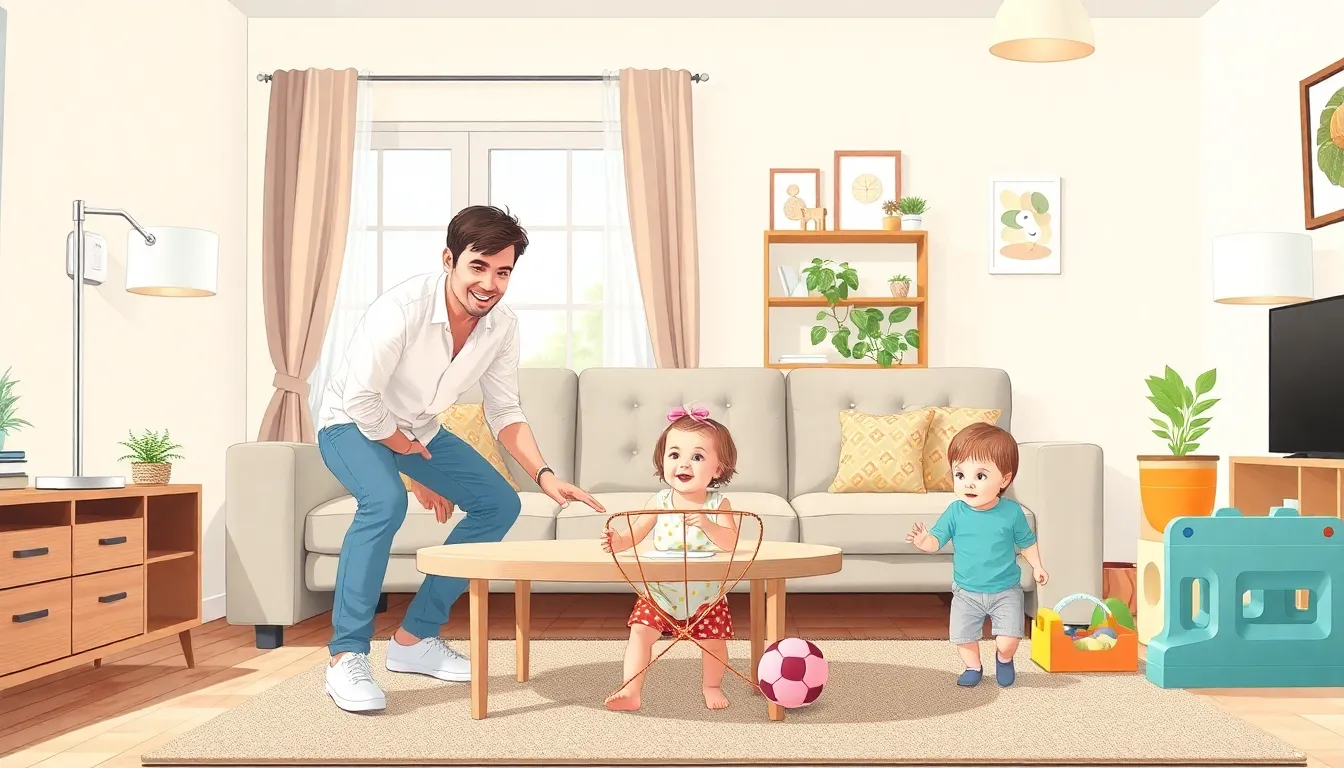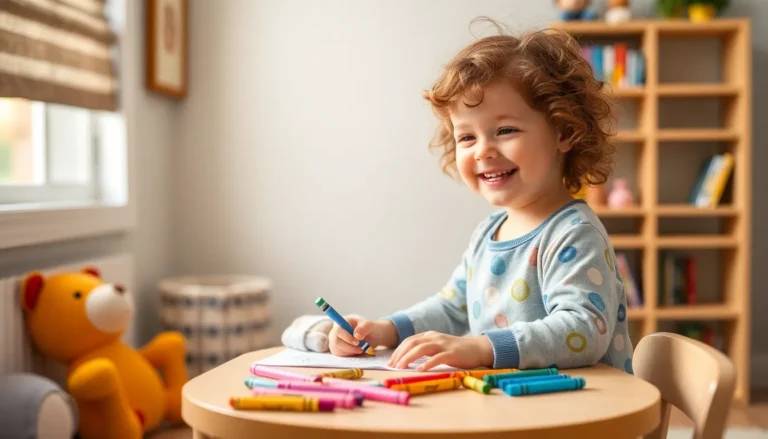Table of Contents
ToggleNavigating the wild world of toddlers is like herding cats—adorable, unpredictable, and occasionally chaotic. As little explorers embark on their adventures, parents and caregivers face the daunting task of ensuring their safety. From curious fingers reaching for the cookie jar to daring leaps off the couch, every moment is a new opportunity for mischief and mayhem.
Understanding Toddler Safety
Toddler safety encompasses various strategies to protect young children as they navigate their environments. Parents must remain vigilant to ensure their little ones explore safely and securely.
Common Risks for Toddlers
Common risks for toddlers include choking hazards, falls, and poisoning. Small objects like coins and toys can lead to choking incidents. Surfaces that are too high or unstable often result in falls. Household products such as cleaning agents pose poisoning threats if not stored properly. Additionally, unsupervised access to staircases and bodies of water can result in dangerous situations. Parents should identify these risks to create a safer living space for their toddlers.
Importance of Safety Awareness
Safety awareness plays a crucial role in preventing injuries among toddlers. Understanding potential dangers allows caregivers to take proactive measures. It’s important for parents to educate themselves about common risks and implement safety precautions throughout the home. Checking for hazards daily ensures a safe exploration environment. Monitoring interactions with other children also protects against accidents. Staying informed about safety updates and best practices can significantly reduce the likelihood of incidents.
Home Safety Tips


Creating a safe environment for toddlers requires deliberate action. Parents can implement safety measures throughout the home to ensure their child’s well-being.
Childproofing Your Home
Parents start by securing furniture and appliances. Install safety latches on cabinets containing hazardous materials. Use outlet covers to prevent electrical accidents, and consider corner guards to protect against sharp edges. Gates at stairs limit access to potentially dangerous areas. Regularly inspecting play areas ensures toys are safe and age-appropriate. Keeping small items out of reach prevents choking hazards. Establishing a safe zone allows toddlers to explore without constant worry.
Safe Furniture Considerations
Selecting the right furniture is crucial for toddler safety. Opt for sturdy tables and chairs with rounded edges. Use furniture anchoring devices to prevent tipping during play. Choose lightweight items that won’t cause severe injury if they fall. Verify that toy chests have safety hinges to avoid pinching fingers. Look for non-toxic finishes to protect children’s health. Ensure that beds and cribs meet current safety standards for sleeping. Regular checks on furniture stability can prevent unexpected accidents.
Outdoor Safety Guidelines
Outdoor safety is essential for toddlers as they explore outside. Parents and caregivers must stay vigilant in various environments.
Playground Safety
Playgrounds provide great opportunities for exercise and social interaction. Equipment must meet safety standards to minimize risks. Inspect play structures regularly for sharp edges and loose components. Soft ground surfaces, such as mulch or rubber mats, help cushion falls. Age-appropriate equipment is crucial; younger toddlers benefit from apparatus specifically designed for their size. Encourage children to use slides in a sitting position and to avoid overcrowded areas. Following these guidelines fosters safe, enjoyable play experiences.
Supervision in Public Spaces
Supervision in public spaces is vital for ensuring toddler safety. Maintaining close visual contact allows quick intervention if needed. Crowded areas pose specific dangers; children can easily become separated from caregivers. Establishing safe meeting points can help manage situations if they arise. Keeping toddlers in designated areas helps prevent wandering into hazardous zones. Engaging children in conversation during outings reinforces their awareness of surroundings. Consistent monitoring enables caregivers to confidently safeguard toddlers during outdoor activities.
Transportation Safety Measures
Transportation safety is crucial for toddlers. Proper safety measures significantly reduce the risk of accidents during travel.
Car Seat Requirements
Car seats should always match a child’s weight and height. Infants require rear-facing seats until they reach at least 30 pounds or 2 years old. Toddlers should transition to forward-facing seats after outgrowing the rear-facing requirement. Up to 65 pounds, they can utilize a harnessed seat. Once they exceed that weight, booster seats become essential. Safety experts recommend keeping children in booster seats until seat belts fit them correctly, typically around 4 feet 9 inches tall. Installing car seats according to manufacturer instructions ensures optimal safety during every ride.
Bicycle and Pedestrian Safety
When it comes to bicycles, properly fitting helmets are non-negotiable. Designing roads with well-marked paths enhances safety for toddlers. Parents should supervise young children while riding their bikes or walking. Teaching kids to look both ways before crossing any street develops safety awareness. Choose sidewalks whenever possible to create a safer environment. For added protection, bright clothing significantly increases visibility in low light situations. Ignoring these safety tips can lead to serious accidents that are otherwise preventable.
Emergency Preparedness for Parents
Effective emergency preparedness remains essential for parents. Understanding first aid and creating a safety plan significantly enhances toddler safety.
First Aid Essentials
A well-stocked first aid kit proves crucial for addressing minor injuries. Include items like adhesive bandages, antiseptic wipes, and sterile gauze. Parents should also consider adding children’s pain relievers and a digital thermometer. Familiarity with basic first aid techniques enables caregivers to manage situations confidently. For instance, knowing how to perform CPR can be lifesaving. Attending a first aid course increases awareness and skills among caregivers, ensuring they’ll respond effectively during emergencies.
Creating a Safety Plan
Developing a safety plan reduces panic during emergencies. Establish clear communication guidelines for family members, including designated meet-up locations. Discuss scenarios like fires, severe weather, or medical emergencies. Practicing evacuation routes helps toddlers learn what to do in a crisis. Encourage regular reviews of the plan to ensure all family members remain informed. Having emergency contacts readily accessible on the fridge or in wallets further aids quick action in urgent situations.
Ensuring toddler safety is a continuous journey that requires dedication and awareness. By implementing effective safety measures at home and while out, parents can significantly reduce risks. Regularly assessing the environment and staying informed about best practices empowers caregivers to create a secure space for their little ones.
Emergency preparedness adds an extra layer of protection, enabling parents to respond swiftly in critical situations. With proactive strategies in place, families can enjoy the joys of parenting while minimizing potential dangers. Keeping toddlers safe is not just about vigilance; it’s about fostering an environment where exploration and learning can flourish without unnecessary risks.







